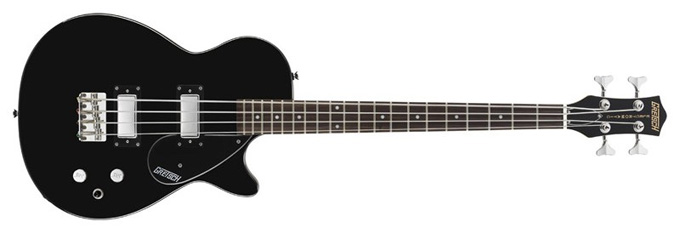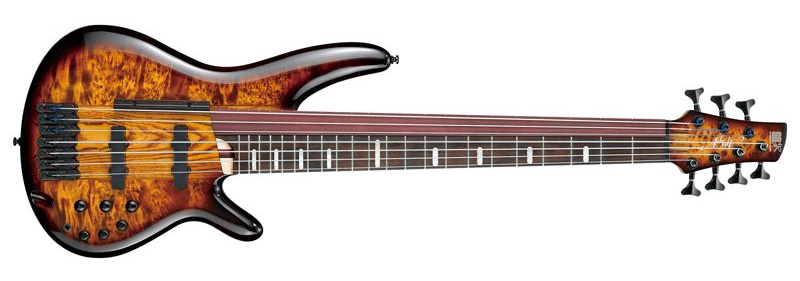Choosing a Bass Guitar
Posted on Mon 22 May 2017 in entries

The world of bass can be a bottomless pit unless you have our bass expert Robin Whitnell's guide to hand...
You'd be forgiven for assuming that a guitar with fewer strings than a regular electric or acoustic might present a simpler set of buying choices… but you’d be wrong. The art of choosing the right bass guitar is every bit as complex and interesting as choosing one of its six- or 12-string counterparts, but hopefully this article will help you discover the perfect bass instrument for you.
As with acoustics and electrics, there are various elements to take into consideration, such as body shape, neck construction, scale length and wood type, all of which affect the sound and the price of your chosen guitar. So let’s begin…
BODY TALK
Most electric bass guitars are solid-body, which means the whole of the main section of the guitar is carved from a single, solid piece of wood. You will, however, come across occasional semi-hollowbody basses that will have a rounder sound, almost acoustic in nature.

The Fender Starcaster Bass](https://www.absolutemusic.co.uk/fender-starcaster-bass-black-maple.html)
Another aspect of the body to take into account is the neck. On a bass the neck can be round, oval, flat-back, ‘vee’ or asymmetrical (thinner either on the bass or treble side). This aspect is all about the comfort in your hands, and if you’re going for a five- or six-string bass (something we’ll come to later) the neck will naturally be wider than that on a four-string.
As with electric and acoustic guitars, it’s quite important to check how the neck is attached to the body. Neck-through basses tend to be stronger and, to my ear, have better sustain and note resolution. Bolt-on necks, found on more affordable guitars, have a punchier sound but are more likely to have dead spots in the frequency range.
ALL ABOUT THE LENGTH
Another thing quoted in the specs of most bass guitars is the scale length and this refers to the vibrating length of the string, measured from the nut to the bridge saddle. As frets are set out according to a ratio based on the scale length, a bass with a longer scale length will have a greater distance between the frets.
Aside from the size of the guitar, scale length also influences the tonal quality of the notes produced and the tension of the string at a particular pitch. The tonal effects of scale length are crucial to the overall tone of the instrument.
A short-scale Gretsch G2220 Junior Jet Bass II
If you’re looking at a four-string bass, don’t be afraid to choose a shorter scale length (say 30 inches) as it’ll be good for younger players or smaller hands, and can actually make the G string sing out. However, if looking at a five-string bass, I’d definitely recommend a longer neck to give more defined sound in those lower notes. For reference, scale lengths are generally given as: short (30”), medium (32”); 4-string long (34”); 5-string long (35”) and extra-long (36”).
TOP TUNERS
The type of tuning machine a bass has is very important as this is what allows you to fine tune the strings and hold the pitch. Enclosed machineheads resist rust as they are protected from airborne moisture, and therefore require less maintenance or replacement than open tuning machines. If in any doubt, give us a call at the guitar workshop (01202 597180) and we’ll recommend the best tuners for your guitar.
Intonation is something else that may be listed in a bass guitar’s specs, and this basically determines how well the notes play in tune as you move your fingers up the neck. If the distance between the frets (usually above the 12th fret) is slightly off, the bass will be incapable of playing in tune and therefore useless for either recording or performing. If in any doubt, drop us a line or call us to find out how your bass of choice matches up.
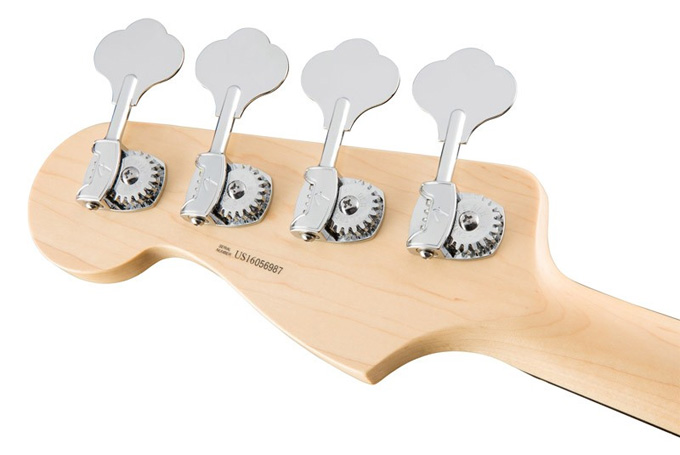
DON'T FRET OVER IT
In contrast to electric and acoustic guitars, a bass guitar can have different numbers of frets: 21, 22 or 24. As most bass repertoire will make use of the lower positions, this is simply a matter of personal taste (and how large a bass you can handle). And of course, you also have the choice of having frets or going for a fretless bass… something you can only begin to consider if you’re an experienced player with a full handle on where the notes are under your fingers.
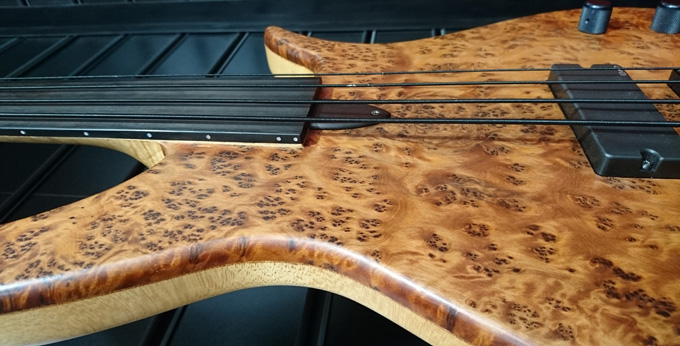
An example of a Fretless bass guitar
You will also find a choice of having a coated or uncoated fingerboard. The uncoated option gives a warmer, more natural sound while a coated fingerboard helps produce a trebly ‘fretless’ sound and longer sustain, and it will also last much longer when using round-wound strings.
PICK IT UP NOW
Pickups are crucially important to the tone of a bass, and are ranked right up there with strings as a way of defining your sound. In fact, I’d say they probably have more effect on your final sound than whatever combination of woods has been chosen to create the perfect tone for a particular guitar.
To complicate the issue, a pickup can give quite different results on different basses, and changing strings will also affect a pickup’s response as well.
A number of active and passive pickups are available for bass guitars (again, email or call us for advice), but remember, when choosing a bass with active pickups, battery life and replacement will become an extra thing to add to your worry list.
FOUR OR FIVE... OR SIX?
Contrary to popular belief, five- and six-string basses aren’t just for show-off players! While a four-string bass will be the right tool for most jobs, having those extra notes means adding extra tunes to your repertoire.
The fifth string on a bass is generally a low B string, a fourth below your low E. A six-string usually adds a C above the G-string, although some players prefer a B-E-A-D-F#-B tuning. Of course, the neck will be a lot wider on a five- or six-string bass than it is on your common-or-garden four-string, but if you’re playing a lot of fancy bass solos or you’re into your Reggae, Dub, Drum’n’Bass, Breakbeat or Modern Soul, those extra strings are indispensable.
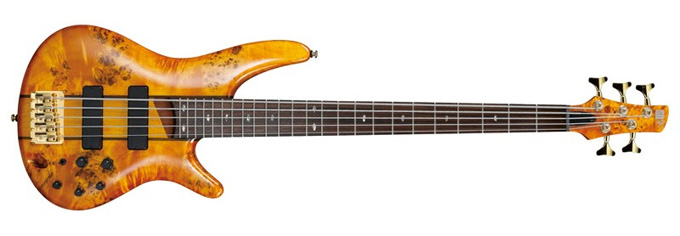 The Ibanez SR805-AM 5 String Bass](https://www.absolutemusic.co.uk/ibanez-sr805-am-5-string-electric-bass-guitar-amber.html)
The Ibanez SR805-AM 5 String Bass](https://www.absolutemusic.co.uk/ibanez-sr805-am-5-string-electric-bass-guitar-amber.html)
WOODN'T IT BE GOOD
Choice of wood in the construction, as we’ve seen in the previous features on electric and acoustic guitars, naturally affects the tone and weight of a guitar, but as I’ve hopefully explained in the previous couple of pages, so do a number of other factors, including pickups, strings, neck construction and neck finish.
Because bass guitars tend to be larger than their electric and acoustic counterparts, having it made of a lightweight wood is advantageous for performing standing up. It’ll definitely be less of a pain in the back (or neck!). One common wood used for basses is swamp ash, a lighter weight soft wood that produces a punchy tone and low mids. Alder is another lightweight wood to look out for, especially as it gives a crisp tone.
The finish on the wood doesn’t affect the sound as much as it does with acoustic guitars, so whether you want a high-gloss or natural finish shouldn’t make a difference to the tone. Basically, if you’ve found a bass guitar that you can physically play well, hold comfortably and with a tone that suits you, go for it!
Failing all of this, if you still can't decide you could just get a bit of everything with this 7-String hybrid Ibanez bass...
